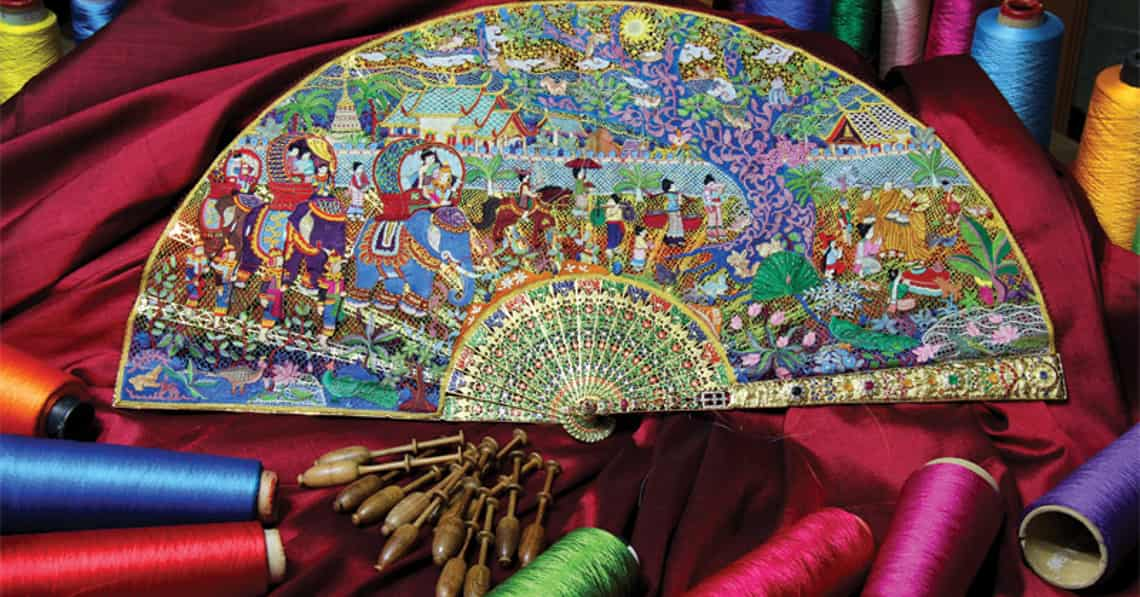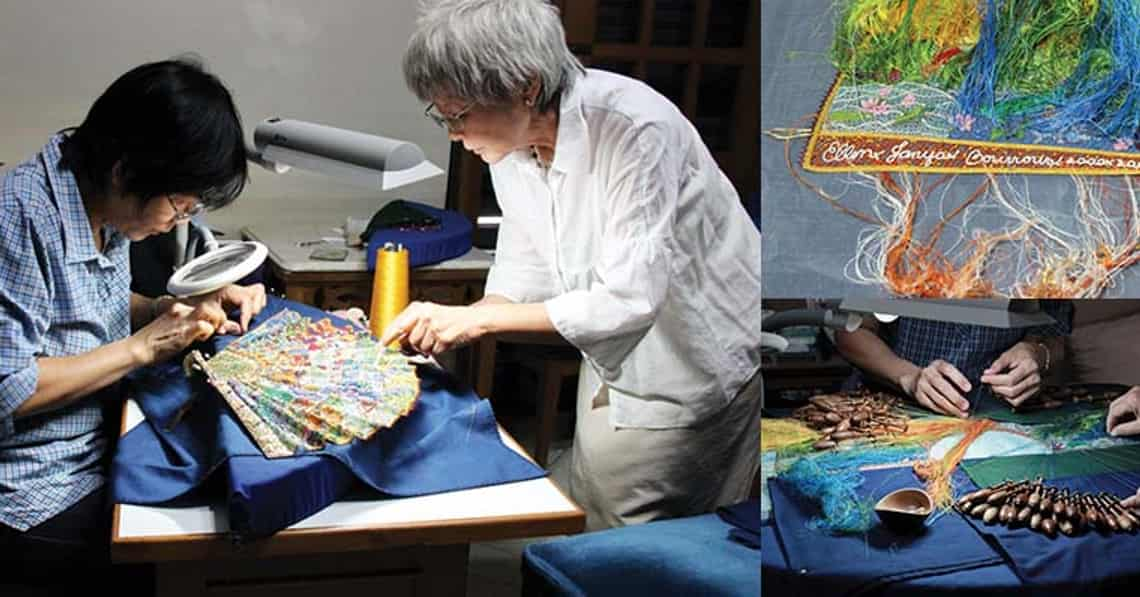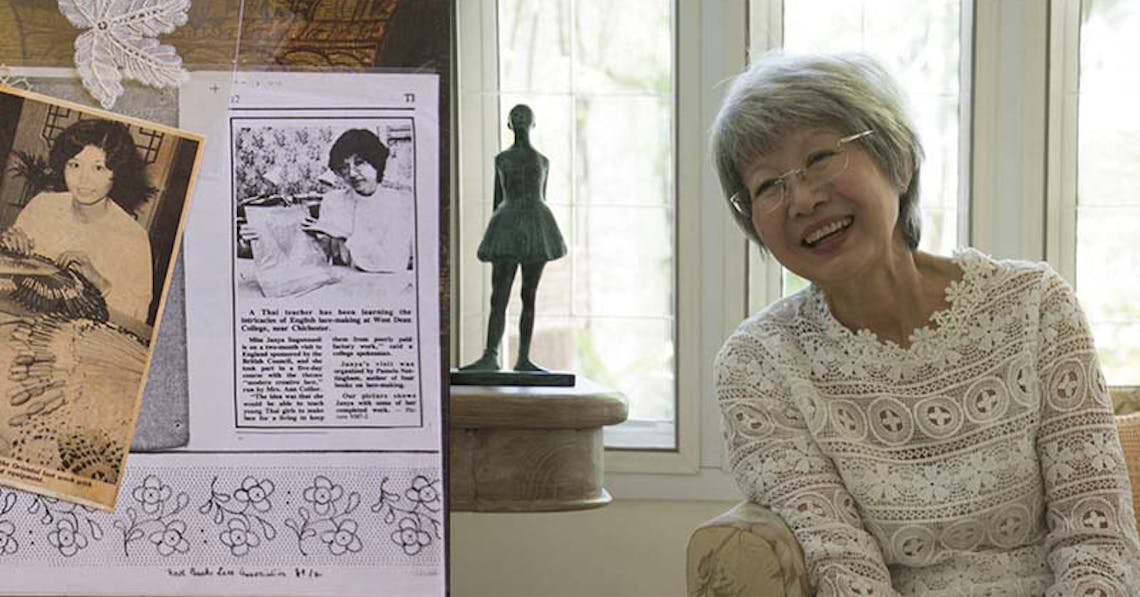Janya Sugunnasil is a petite lady in her 60s, with a white bob, delicate features and merrily smiling eyes. The sliding screen door of her Wat Umong home bears a sign in Thai, politely warning us not to let out the cats. We enter and the room is clean and bright (no cats in sight) with muted colours and small pieces of antique-looking art scattered about – a bronze ballerina sculpture, a small wooden stool carved with dragons. A porcelain teacup full of live flowers sits on the glass-topped coffee table and Janya sits down on the couch by the window with her hands folded primly in her lap, wearing a long floral skirt, house slippers and a white lace top.
“Did you make that shirt yourself?” I ask. An odd icebreaker perhaps, but this is, after all, the Lady of Lace, Thailand’s very first lacemaker.
“Oh, no,” Janya says with a laugh that sounds like bells. “This is machine lace.”
And this is what Janya is like, despite her background, despite her success. Her story is as quiet as her craft, which Citylife first discovered 10 years ago, when former deputy editor Cindy Tilney put Janya’s story on paper for the first time. It is the story of a woman who dreamt in lace, of all things, who woke every morning to visions of lace dresses, despite being from Thailand, a country in which lacemaking was then a nonexistent craft; despite being daughter to the owner of a chain of gas stations, as well as the popular Sompetch Market, expected to take over the family business; despite being a single mother, divorced at a time when the practice was rare and deeply frowned upon.

A Story of Lace
It was 30 years ago that Janya began making lace. She was already in her early 30s then, and shows me a yellowed newspaper photo from an old scrapbook, a beautiful young woman with thick hair and a beaming smile.
“At that time, lacemaking was a dying art, and no one else did it in Thailand,” Janya recalls. Globally, machine lace was taking over, as a far quicker alternative to the glacial pace of handmade lace. But Janya was initiated into the world of handmade bobbin lace a Dutch woman living in Malaysia, introduced by a mutual friend. The woman’s name was Anthonetta Graulich, but Janya called her Nettie.
Bobbin lace is a complicated craft in which intricate lace designs are made by hand using a series of small wooden cylinders (called bobbins) to braid and twist lengths of thread around needles poked though a pillow. Janya and her young daughter Pardi spent a month living and learning with Nettie at her home in Kuala Lumpur.
“Nettie was an excellent teacher,” says Janya. “She made you feel like you wanted to do your best.” After a month, Janya returned to Chiang Mai with nothing but a lacemaking book and a newfound passion. Back in Thailand, she continued teaching herself how to make bobbin lace, while maintaining close contact with Nettie. The two would send lacework back and forth by mail, Nettie recording her evaluations and advice on cassette tapes, Janya asking questions and learning as she went along.
“Lacemaking is a dying art but if it’s going to prosper again, it will be in Chiang Mai,” Nettie told Janya when she came to visit her in Chiang Mai and first witnessed the city’s passion for handicrafts. At the time, Janya was using expensive linen imported from Europe to make her lace, so when Nettie came, the two went about looking for another more accessible material to use. The obvious answer? Silk, a textile quite common to Thailand – in fact, Janya’s uncle had his own factory. Silk had been used to make lace in ancient times, but was all but obsolete by the time Janya took it up.
From there, things just started happening. Janya’s lacemaking skills were quickly recognised by the global lacemaking community (a tight-knit and passionate one, she tells me) and she was soon invited to showcase her rare silk laceworks at the prestigious World Lace Congress in Utrecht, Netherlands. There, her booth was always full, and the silk she brought along sold like hotcakes. The silk bobbin lace became an international sensation and she travelled the world attending various conferences and conventions and learning directly from the world’s leading lace experts, including Pamela Nottingham of England, who literally wrote the book on bobbin lace and invited Janya to live and learn with her in the UK.
As the world’s interest in handmade lace underwent a revival, Janya opened a shop in Chiang Mai’s old city called Saraphi Lace, located in a quiet second floor space above the touring masses on Ratwithi Road. She also travelled to several surrounding villages in search of students and future employees. Her initial attempts to teach hill tribe woman were not successful. “They were too busy to learn,” she recalls. “Then I went to another village, but the girls there were well-to-do, and just not very keen to learn lacemaking.” Then she found a village in Sansai that was just right, and began teaching a group of young locals every day. That was where she found the girl who would grow up to be her head lacemaker and an eventual leader in the craft, Bourrour Promkeaw, then only 12 years old.
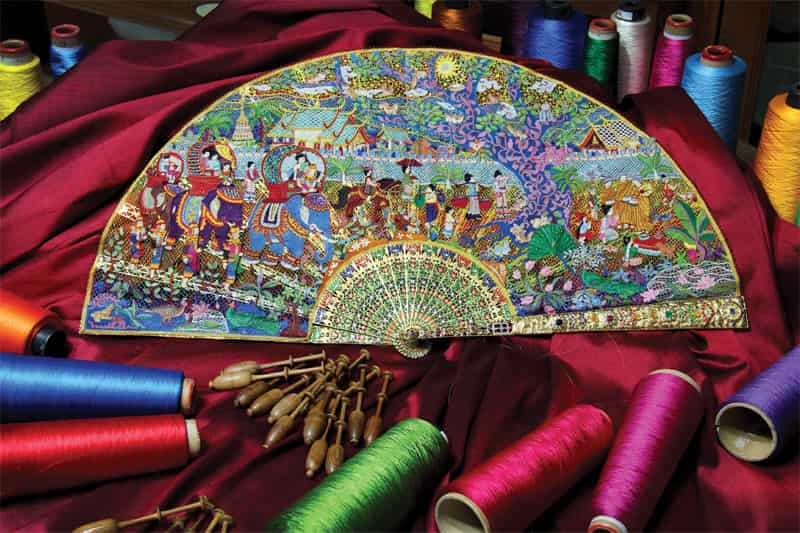
Enter the Fan
It was the year 2000 when everything changed. Way over on the other side of the world, a wealthy American and avid fan collector named Ellen Dennis was on a trip to England when she saw a fan unlike any she’d seen before, a handmade lace masterpiece she was dying to add to her collection. The fan, however, was not for sale.
Not one to be dissuaded, Ellen took to the internet and began a search that extended from America to Europe to Australia. She was beginning to lose hope when Janya found her posting on a web forum and sent a few photos of her lacework. While she had never done any work with coloured silk before, nor had she done it in such a small size, Janya was willing to try, and after Ellen saw her talent, she was willing to pay for her efforts.
“It was something I never dreamed I would make, but Ellen had a vision,” recalls Janya. “It’s the ideal order for any lacemaker, don’t you think? It was the opportunity of a lifetime for me, a chance to do something wonderful.”
And so the project began. Janya called upon celebrated Chiang Mai painter Kriengkrai Muangmool, the man responsible for the stunning pointillist murals inside Wat Jed Yod, to create the design. Based on Ellen’s broad request (“She wanted a fan with tigers, snakes, stars, sun, moon – everything!”) Kriengkrai drew up several sketches to send to America. When the final image was chosen – an ornate and distinctly Lanna scene featuring several monks and a beautiful woman riding a parade of elephants in front of a large tree, the bright yellow sun peeking through its branches – Janya got to work copying it into an intricate lace pattern, which she then passed on to her lacemaker, Bourrour, to weave with delicate threads of dyed silk from Janya’s uncle’s factory.
“We planned to finish in three years, but we kept adding more and more details,” says Janya. “Then, when the time was almost up I took the fan to America where my daughter lives in Seattle. Ellen came to visit me there and I told her, ‘It’s nearly finished, but now we have to hurry.’ She looked at the lace for three hours with a magnifying glass and then said, “Forget about the time. Make it as detailed as possible. I will wait as long as I have to.’”
And so she has, for it was just last month, a full 13 years after the project began, that the fan was finally finished. That’s right, 13 years.
I ask Janya if the time was lengthened because she was working on many other projects at the same time. She says no; for all those years, the fan was her main focus. Her other lacemakers kept up with other jobs at the workshop, but Janya and Bourrour focused almost exclusively on the fan. This is a glimpse into the world of bobbin lacemaking – even just a few square centimetres can take months to pattern and assemble, and any imperfections must be dismantled and redone (“They say I’m a perfectionist…at least in lace!” declares Janya).
She recalls a funny story from a decade ago, when Ellen told her that she wanted to have the most beautiful bobbin lace fan of the century. “At the time, my English was so poor that I thought a century was only ten years,” Janya remembers with a giggle. “But it was probably a blessing – less pressure!” It wasn’t until the fan was nearly finished, over a decade into its making, that she realised the true length of a century. “I had lots of sleepless nights then – I was so worried!”
Indeed, everything Janya tells me about her work is marked by a deep sense of modesty. Despite the fact that people come to visit her from all over the world to learn about lace, despite the awards and the commissions, despite even the fact that she is Thailand’s first lacemaker (a fact she omits entirely from our interview until I bring it up myself), she remains humble and deeply human. When I ask her if she sees herself as a mentor to those she teaches, she seems surprised and a little embarrassed. “Oh no,” she says. “Not a mentor!” She credits her teacher Nettie for much of her success, and heaps praises upon all who have helped in her journey. “I learned as I went, and there were many times when I had problems. But it seemed that whenever that happened, other lacemakers would come and visit me, and we’d figure it out together.”
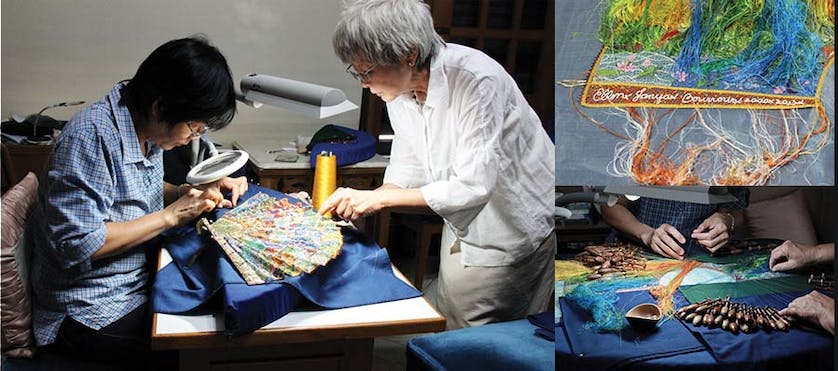
Letting Go
When the 13-year fan was finally in its final stages, Janya was overcome with doubt. “I was embarrassed and I didn’t want anyone to look at it!” she recalls. “But then one friend did, and she said it was beautiful. I was so relieved! So then I started asking people to come have a look. They liked it, too! Then I felt peaceful again.”
After the fan was finally complete and sent to its new home in the States, Janya went home and meditated for ten days in her house. Then, she went for an extended rest at a friend’s home in Bangkok. Two days after her return to Chiang Mai was when I met her.
“They say people who like handicrafts, once they learn how to make lace, they never want to do anything else.” Janya smiles. “That’s not really true – I have one student who went on to become a cupcake decorator! – but it teaches you a lot. It teaches patience, attention to detail. Nothing is impossible after you make lace.” (Indeed, Janya’s own daughter, who learned lacemaking from her, is now an engineer in the States.)
The practice is also therapeutic in and of itself, something that becomes clear as soon as you encounter Janya and her zen-like calm. “Lacemaking is very soothing,” she continues. “The sound of the bobbin is beautiful, peaceful. It’s not easy, of course. Lacemaking can be a problem, but it’s a problem that can be solved.”
As we chat, Janya brings out a plastic box full of lacework. “These are practice pieces,” she tells me. “They aren’t perfect.” I find that hard to believe, gazing at the cellophane sleeves of intricate silk designs – intricate leaves and petals woven into a circular collar, flowers, butterflies, a cat, a snake – each gossamer thin, bone white, plaited into loops no bigger than the tip of a needle.
“Lacemaking is a
problem, but it’s a
problem that can
be solved.”
“Oh, I forgot to tell you about the fan stick,” Janya tells me, reaching for her iPad and scrolling through the digital photo library. “Lots of fans have sticks made of mother-of-pearl, but because this fan was so delicate, it was not possible to make it thin enough. So we thought of bone, but the only bones you can really find in Thailand are elephant, and we didn’t want that. So then a friend from Maine offered me some moose bones! But for some reason they were buried underground and she couldn’t dig them up until spring.” I raise my eyebrows and she shrugs and continues. “Silver wouldn’t work because it changes colour, and would turn the silk black. So the only thing left was gold.”
Janya originally commissioned one of Bangkok’s best jewellers to make the golden fan sticks, but the final estimate had them weighing in at three or four kilos – way too heavy for a dainty silk fan. Then someone told her about a goldsmith right here in Chiang Mai who was also a jewellery designer.
“It was like finding an architect who is also an engineer!” Janya exclaims. And so, local jewelsmith Prayuth Srithong created a dainty set of 15 golden sticks, each carved into intricate patterns, inlaid with colour and engraved with the name of a different member of the fan’s creative team (and the project dates, 2000 – 2013. “But didn’t it actually finish in 2014?” I ask. “Well, yes,” Janya replies. “But that’s what’s engraved so now that’s what it is!”). The guard stick is set with emeralds, rubies and sapphires, with the owner’s initials, “ED,” spelled out in diamonds.
I ask Janya the price of this extraordinary fan, but she tells me this is the one thing Ellen forbade her to disclose. I do know that it was enough to keep Janya and her team comfortably employed for 13 years, not to mention the cost of its opulent materials.
Ellen has one of the best fan collections in America, Janya tells me, and has been collecting since she was a teen. When I ask why, Janya replies with a smile and a little shrug. “Perhaps she loves fans!”
More than anything else, Janya feels deep gratitude toward this collector of fans, who she sees as a kind of benefactor, someone who trusted her enough to wait 13 years for a dream. “When she saw the fan for the first time, she said, ‘It’s stunning, in a very good way! There’s nothing I don’t like about it,’” Janya tells me of Ellen’s reaction. The collector presented her new fan at an assemblage in America before bringing it home, where she put it on display in her bedroom so she can look at it all the time. Eventually, she will donate her fan of the century (for that is indeed what it is, she confirmed) and the rest of her collection to a museum, but Janya doesn’t know where or when.
“It’s out of my hands now,” she says, “and the biggest thing I feel is relief.”
Update: Citylife is pleased to report that Janya has been commissioned by a client to produce a beautiful new fan. We can’t wait for a glimpse of her new creation, but of course, we must.
Contact Info:
janyalace@gmail.com
janya2@hotmail.com
